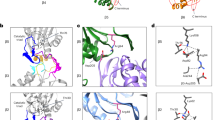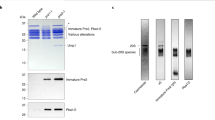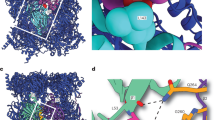Abstract
The proteasomal ATPase ring, comprising Rpt1–Rpt6, associates with the heptameric α-ring of the proteasome core particle (CP) in the mature proteasome, with the Rpt carboxy-terminal tails inserting into pockets of the α-ring1,2,3,4. Rpt ring assembly is mediated by four chaperones, each binding a distinct Rpt subunit5,6,7,8,9,10. Here we report that the base subassembly of the Saccharomyces cerevisiae proteasome, which includes the Rpt ring, forms a high-affinity complex with the CP. This complex is subject to active dissociation by the chaperones Hsm3, Nas6 and Rpn14. Chaperone-mediated dissociation was abrogated by a non-hydrolysable ATP analogue, indicating that chaperone action is coupled to nucleotide hydrolysis by the Rpt ring. Unexpectedly, synthetic Rpt tail peptides bound α-pockets with poor specificity, except for Rpt6, which uniquely bound the α2/α3-pocket. Although the Rpt6 tail is not visualized within an α-pocket in mature proteasomes2,3,4, it inserts into the α2/α3-pocket in the base–CP complex and is important for complex formation. Thus, the Rpt–CP interface is reconfigured when the lid complex joins the nascent proteasome to form the mature holoenzyme.
This is a preview of subscription content, access via your institution
Access options
Subscribe to this journal
Receive 51 print issues and online access
$199.00 per year
only $3.90 per issue
Buy this article
- Purchase on Springer Link
- Instant access to full article PDF
Prices may be subject to local taxes which are calculated during checkout





Similar content being viewed by others
Accession codes
Primary accessions
Electron Microscopy Data Bank
Protein Data Bank
Data deposits
Data have been deposited in the Electron Microscopy Data Bank under the following accession numbers: free CP, EMD-5593; Rpt1–CP, EMD-5611; Rpt2–CP, EMD-5612; Rpt3–CP, EMD-5613; Rpt4–CP, EMD-5614; Rpt5–CP, EMD-5615; Rpt6–CP, EMD-5616; and base1–CP: EMD-5617. For the crystal structures, data have been deposited in the Protein Data Bank under accessions 4FP7 (Hsm3) and 4JPO (Hsm3–Rpt1 C domain).
References
Kish-Trier, E. & Hill, C. P. Structural biology of the proteasome. Ann. Rev.. Biophyshttp://dx.doi.org/10.1146/annurev-biophys-083012-130417 (2013)
Lander, G. C. et al. Complete subunit architecture of the proteasome regulatory particle. Nature 482, 186–191 (2012)
Lasker, K. et al. Molecular architecture of the 26S proteasome holocomplex determined by an integrative approach. Proc. Natl Acad. Sci. USA 109, 1380–1387 (2012)
Beck, F. et al. Near-atomic resolution structural model of the yeast 26S proteasome. Proc. Natl Acad. Sci. USA 109, 14870–14875 (2012)
Roelofs, J. et al. Chaperone-mediated pathway of proteasome regulatory particle assembly. Nature 459, 861–865 (2009)
Park, S. et al. Hexameric assembly of the proteasomal ATPases is templated through their C termini. Nature 459, 866–870 (2009)
Le Tallec, B., Barrault, M. B., Guerois, R., Carre, T. & Peyroche, A. Hsm3/S5b participates in the assembly pathway of the 19S regulatory particle of the proteasome. Mol. Cell 33, 389–399 (2009)
Kaneko, T. et al. Assembly pathway of the mammalian proteasome base subcomplex is mediated by multiple specific chaperones. Cell 137, 914–925 (2009)
Saeki, Y., Toh, E. A., Kudo, T., Kawamura, H. & Tanaka, K. Multiple proteasome-interacting proteins assist the assembly of the yeast 19S regulatory particle. Cell 137, 900–913 (2009)
Funakoshi, M., Tomko, R. J., Jr, Kobayashi, H. & Hochstrasser, M. Multiple assembly chaperones govern biogenesis of the proteasome regulatory particle base. Cell 137, 887–899 (2009)
Forster, A., Masters, E. I., Whitby, F. G., Robinson, H. & Hill, C. P. The 1.9 Å structure of a proteasome-11S activator complex and implications for proteasome-PAN/PA700 interactions. Mol. Cell 18, 589–599 (2005)
Smith, D. M. et al. Docking of the proteasomal ATPases’ carboxyl termini in the 20S proteasome’s α ring opens the gate for substrate entry. Mol. Cell 27, 731–744 (2007)
Rabl, J. et al. Mechanism of gate opening in the 20S proteasome by the proteasomal ATPases. Mol. Cell 30, 360–368 (2008)
Smith, D. M. et al. ATP binding to PAN or the 26S ATPases causes association with the 20S proteasome, gate opening, and translocation of unfolded proteins. Mol. Cell 20, 687–698 (2005)
Park, S., Kim, W., Tian, G., Gygi, S. P. & Finley, D. Structural defects in the RP-CP interface induce a novel proteasome stress response. J. Biol. Chem. 286, 36652–36666 (2011)
Kusmierczyk, A. R., Kunjappu, M. J., Funakoshi, M. & Hochstrasser, M. A multimeric assembly factor controls the formation of alternative 20S proteasomes. Nature Struct. Mol. Biol. 15, 237–244 (2008)
Tomko, R. J., Jr, Funakoshi, M., Schneider, K., Wang, J. & Hochstrasser, M. Heterohexameric ring arrangement of the eukaryotic proteasomal ATPases: implications for proteasome structure and assembly. Mol. Cell 38, 393–403 (2010)
Ghaemmaghami, S. et al. Global analysis of protein expression in yeast. Nature 425, 737–741 (2003)
Takagi, K. et al. Structural basis for specific recognition of Rpt1, an ATPase subunit of 26S proteasome, by proteasome-dedicated chaperone Hsm3p. J. Biol. Chem. 287, 12172–12182 (2012)
Barrault, M. B. et al. Dual functions of the Hsm3 protein in chaperoning and scaffolding regulatory particle subunits during the proteasome assembly. Proc. Natl Acad. Sci. USA 109, E1001–E1010 (2012)
Nakamura, Y. et al. Structural basis for the recognition between the regulatory particles Nas6 and Rpt3 of the yeast 26S proteasome. Biochem. Biophys. Res. Commun. 359, 503–509 (2007)
Tian, G. et al. An asymmetric interface between the regulatory particle and core particle of the proteasome. Nature Struct. Mol. Biol. 18, 1259–1267 (2011)
Pathare, G. R. et al. The proteasomal subunit Rpn6 is a molecular clamp holding the core and regulatory subcomplexes together. Proc. Natl Acad. Sci. USA 109, 149–154 (2012)
Smith, D. M., Fraga, H., Reis, C., Kafri, G. & Goldberg, A. L. ATP binds to proteasomal ATPases in pairs with distinct functional effects, implying an ordered reaction cycle. Cell 144, 526–538 (2011)
Thompson, D., Hakala, K. & DeMartino, G. N. Subcomplexes of PA700, the 19S regulator of the 26S proteasome, reveal relative roles of AAA subunits in 26S proteasome assembly and activation and ATPase activity. J. Biol. Chem. 284, 24891–24903 (2009)
Acknowledgements
We thank M. Schmidt, T. Walz, C. Chen, and Finley laboratory members for suggestions, and C. Mann for antibodies. This work was supported in part by grants from the National Institutes of Health (NIH; R01GM082893 and 1S10RR026814-01), the University of California San Francisco Program for Breakthrough Biomedical Research (New Technology Award) to Y.C.; the Johnson Cancer Research Center, the National Center for Research Resources (5P20RR017708 and P20 RR016475) and NIH (8 P20 GM103420 and P20 GM103418) to J.R.; and grants from the NIH to P.C. (R01GM045335) and D.F. (R37GM043601). S.P. was supported by the Charles A. King Trust Postdoctoral Research Fellowship Program of the Medical Foundation. Use of IMCA-CAT was supported by the Industrial Macromolecular Crystallography Association though a contract with the Hauptman-Woodward MRI. Use of the Advanced Photon Source was supported by the US Department of Energy (contract no. DE-AC02-06CH11357).
Author information
Authors and Affiliations
Contributions
S.P. performed reconstitution of the base–CP complex and holoenzyme stability. X.L. performed all cryoEM experiments and analysis. H.M.K. and C.R.S. generated yeast strains. H.M.K. purified GST-fused CP, and participated in cryoEM experiments and analysis. C.R.S. performed purifications, and M.Z. performed ultracentrifugation. K.P.B. and S.L. determined crystal structures, J.R. and G.T. performed structural analysis and modelling. M.A.H., H.M.K. and P.C. performed phenotypic and native gel analysis of Rpt6 mutations. J.R. wrote the supplement with contributions from all authors. The manuscript was drafted by D.F. and Y.C., and modified by all authors.
Corresponding authors
Ethics declarations
Competing interests
The authors declare no competing financial interests.
Supplementary information
Supplementary Information
This file contains Supplementary Figures 1-21, Supplementary Tables 1-3, Supplementary Methods and Supplementary References. (PDF 12079 kb)
Rights and permissions
About this article
Cite this article
Park, S., Li, X., Kim, H. et al. Reconfiguration of the proteasome during chaperone-mediated assembly. Nature 497, 512–516 (2013). https://doi.org/10.1038/nature12123
Received:
Accepted:
Published:
Issue Date:
DOI: https://doi.org/10.1038/nature12123
This article is cited by
-
Proteasome regulation by reversible tyrosine phosphorylation at the membrane
Oncogene (2021)
-
Conformational maps of human 20S proteasomes reveal PA28- and immuno-dependent inter-ring crosstalks
Nature Communications (2020)
-
Regulation of proteasome assembly and activity in health and disease
Nature Reviews Molecular Cell Biology (2018)
-
Delineation of molecular pathway activities of the chronic antidepressant treatment response suggests important roles for glutamatergic and ubiquitin–proteasome systems
Translational Psychiatry (2017)
-
An atomic structure of the human 26S proteasome
Nature Structural & Molecular Biology (2016)
Comments
By submitting a comment you agree to abide by our Terms and Community Guidelines. If you find something abusive or that does not comply with our terms or guidelines please flag it as inappropriate.



